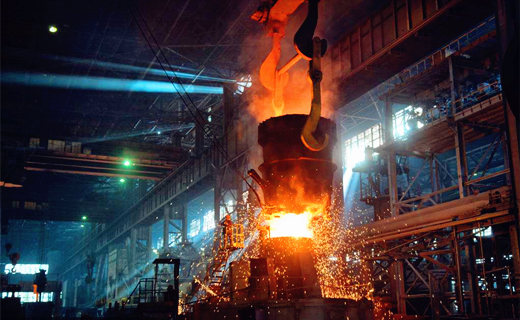The structure of electric arc furnace includes furnace cover (furnace top) and furnace body. The furnace cover is movable, and the outer ring is made of steel. Most of them are water jacket type. Except for water-cooled parts, the rest are made of refractory fire bricks. The furnace cover is provided with three electrode holes through which three graphite electrodes are inserted into the furnace. The furnace body is composed of furnace bottom, furnace slope and furnace wall, built with refractory bricks and wrapped with steel furnace shell. One side of the furnace wall is provided with a furnace door, and the other side is a tapping hole and connected with the tapping trough.

Electric arc furnace uses electric arc heating to melt metal for smelting, and the raw material is scrap. The melting period is long, the temperature in the furnace is high, and the atmosphere changes greatly. Generally, the melting period accounts for about half of the smelting time. The electric arc furnace steelmaking process generally adopts the slag refining in oxidation period and reduction period, that is, the alkaline double slag process. In some cases, molten steel is poured into ladle for refining and alloying after making oxide slag.
The electric arc furnace lining is mainly eroded by molten slag, the erosion of molten steel, molten slag and air, and the mechanical impact of scrap loading, and is subject to high temperature and strong thermal radiation. The hot spots of the furnace lining are very easy to be damaged. With the frequent operations such as feeding and melting, the furnace cover is often opened, and the thermal shock effect of the furnace top and lining is also prominent. If the surface temperature of furnace lining reaches above 1600 ℃ during tapping, it is about 1000 ℃ during charging and only about 500 ℃ during reheating. Therefore, the working conditions of refractory bricks are harsh and harsh.
Common refractory bricks for various parts of electric arc furnace are as follows:
(1) Furnace cover. During the melting and refining process, the furnace cover temperature is very high. During tapping, after the furnace cover is removed, it is immediately under room temperature. The temperature changes suddenly and the thermal stress is very large. During melting and refining, it is also affected by the splashing erosion of slag and furnace dust and the change of atmosphere.
In the past, the furnace cover of electric furnace was mainly built with silica brick, but due to its low fire resistance and poor thermal shock resistance, slag corrosion, molten drop and spalling damage occurred, resulting in short service life. Now, high alumina bricks and high alumina amorphous refractories with excellent performance are widely used, and their service life is 2-3 times higher than that of silicon bricks. On large ultra-high power electric furnaces, fired or unburned alkali bricks are used because of the worse working conditions. However, due to the low high-temperature strength and heavy self weight of the refractory bricks, they are mostly hanging structures. Using directly bonded magnesia brick and magnesia chrome brick is better than common magnesia brick and magnesia chrome brick, which can greatly reduce the spalling damage caused by structural cracking and thermal cracking.
(2) Furnace wall. The furnace wall of the electric arc furnace is close to the arc and molten pool, and is more seriously affected by high-temperature heat radiation, slag and molten steel splash than the furnace cover. The atmosphere and temperature in the furnace change greatly, and are impacted by scrap steel and eroded by melt at the same time. The furnace wall is easily damaged due to the comprehensive influence of various functions. Local melting loss often occurs at the hot spot near the electrode, where the furnace wall is more seriously damaged.
According to the characteristics of electric furnace smelting process, thermal system and slag properties, almost all furnace walls are made of alkaline refractory bricks. In general furnace wall, magnesia brick and magnesia chrome brick are mostly used. In addition to using fired products and fired bricks in combination with unburned bricks, the effect of using unburned bricks is also very good. Domestic small electric furnaces mainly use tar asphalt combined dolomite bricks and tar impregnated dolomite bricks, as well as magnesia and dolomite ramming materials combined with tar asphalt. Slag line area is the weak link of electric arc furnace, most of which have adopted directly bonded magnesia brick and magnesia chrome brick. On large electric furnaces, fused cast magnesia chrome bricks or fused and recombined magnesia bricks, magnesia chrome bricks, magnesia carbon bricks or carbon bricks are used. As lining materials for hot spots, the service life of these refractory bricks is increased by more than 2 times.
(3) Furnace bottom. The furnace bottom and dike slope form a molten pool, which is the part for charging and containing molten steel, and is in direct contact with molten steel and molten liquid layer. Some electric furnaces also blow oxygen and slag into molten steel for refining. Therefore, the bottom of the furnace is corroded by molten steel and slag, and the slag corrosion near the slag line is very serious. The furnace bottom reacts with molten slag and iron oxide to form a metamorphic layer. In addition to melting corrosion, slag corrosion and structural cracking, molten steel often infiltrates into the furnace bottom and floats the furnace bottom. At the same time, the furnace bottom also has to withstand the effect of high temperature and the impact of scrap steel and temperature changes. Therefore, the furnace bottom often has local damage, which should be repaired in time to maintain normal production.
Based on the above reasons, in the past, magnesia and dolomite sand or a mixture of both were used to tamp the working lining at the bottom of the furnace, and the non working layer below was sintered magnesia brick. At present, high-purity magnesia and synthetic magnesia dolomite sand are used to tamp the working lining on the sintered magnesia brick layer, or magnesia or dolomite fired brick working lining is used.
The upper part of the embankment slope is connected with the slag line, and the slag corrosion is serious. Refractory bricks of the same or similar material as the hot spot of the furnace wall are mostly used. For example, directly bonded bricks, magnesia carbon bricks, fused cast magnesia chrome bricks or fused fused and recombined magnesia chrome bricks are used.
The lining of tapping tank shall have good thermal conductivity, strong slag corrosion resistance, impact resistance and no slag hanging. Therefore, large sections are generally used. Such as high alumina carbon, silicon carbide, carbon and magnesium high alumina bricks. It can be built, tamped or vibrated


 Wechat Us
Wechat Us